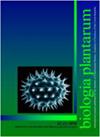田间栽培低温胁迫麻黄中亲脂性抗氧化剂积累的研究
IF 0.8
4区 生物学
Q4 PLANT SCIENCES
引用次数: 0
摘要
研究了雅库特中部自然条件下常绿灌木麻黄同化芽中亲脂性抗氧化剂β-胡萝卜素(β-Car)、玉米黄质(Zx)、α-生育酚(α-Toc)、质体醌(PQ)/质体醌(PQH2)含量的季节变化规律。光周期的缩短和温度的季节性降低导致α-Toc含量增加了1.4倍。10月日平均气温从0.1℃下降到-8.1Â℃,由于rhodoxanthin (Rhd)的积累,导致β-Car含量下降。在此期间,还检测到隔夜残留的Zx含量急剧增加。在冬季,Zx和α-Toc含量持续升高。9月PQH2和PQ含量分别比7月增加了2.5倍和1.4倍。开始暴露在-3至-5°C的冰冻日平均温度下导致总PQ池枯竭18%。而PQtot在冬季的含量是7月底的1.5倍。结果表明,在麻黄抗冻性发育过程中,各抗氧化剂的变化时间和温度范围不同。本文章由计算机程序翻译,如有差异,请以英文原文为准。
Exploring lipophilic antioxidants accumulation in field-grown low temperature-stressed Ephedra monosperma
The seasonal patterns of changes in the content of lipophilic antioxidants β-carotene (β-Car), zeaxanthin (Zx), α-tocopherol (α-Toc), plastoquinone (PQ)/plastoquinol (PQH2) were studied in the assimilating shoots of evergreen shrub Ephedra monosperma J.G. Gmel ex C.A. Mey under natural conditions of Central Yakutia. The shortening of the photoperiod and the seasonal decrease in temperature induced a 1.4-fold increase in α-Toc content. The fall in the average daily temperature from 0.1 to -8.1°C in October led to a decrease in the content of β-Car as a result of the accumulation of rhodoxanthin (Rhd). In this period a sharp increase in the content of Zx retained overnight was also detected. In winter, elevated content of Zx and α-Toc persisted. During September, the content of PQH2 increased by 2.5 times and PQ by 1.4 times (compared to July). The beginning of exposure to freezing average daily temperatures from -3 to -5°C led to the depletion of the total PQ pool by 18%. However, the content of PQtot in the winter months was 1.5 times higher than at the end of July. The results revealed different timing and temperature ranges of variation for individual antioxidants during the development of frost resistance in ephedra.
求助全文
通过发布文献求助,成功后即可免费获取论文全文。
去求助
来源期刊

Biologia Plantarum
生物-植物科学
CiteScore
2.80
自引率
0.00%
发文量
28
审稿时长
3.3 months
期刊介绍:
BIOLOGIA PLANTARUM is an international journal for experimental botany. It publishes original scientific papers and brief communications, reviews on specialized topics, and book reviews in plant physiology, plant biochemistry and biophysics, physiological anatomy, ecophysiology, genetics, molecular biology, cell biology, evolution, and pathophysiology. All papers should contribute substantially to the current level of plant science and combine originality with a potential general interest. The journal focuses on model and crop plants, as well as on under-investigated species.
 求助内容:
求助内容: 应助结果提醒方式:
应助结果提醒方式:


